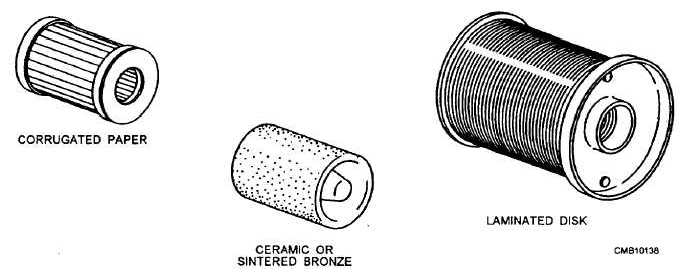Home > Construction Training Manuals > Construction Mechanic Basic > Figure 4-9.Fuel Filter Elements.

Figure 4-9. - Fuel filter elements.
pump uses a back-and-forth motion, it is a reciprocating pump. They are usually powered by an eccentric (egg- shaped lobe) on the engine camshaft.
The parts of a basic mechanical fuel pump are the rocker arm, the return spring, the diaphragm, the diaphragm spring, and the check valves.
The ROCKER ARM, also called an actuating lever, is a metal arm hinged in the middle. A small pin passes through the arm and fuel pump body. The outer end of the arm rides on the camshaft eccentric and the inner end operates the diaphragm.
The RETURN SPRING keeps the rocker arm pressed against the eccentric. Without a return spring, the rocker arm would make a loud clattering sound, as the eccentric lobe hits the rocker arm.
The DIAPHRAGM is a synthetic rubber disc clamped between two halves of the pump body. The core of the diaphragm is usually cloth that adds strength and durability. A metal pull rod is mounted on the diaphragm to connect the diaphragm with the rocker arm.
The DIAPHRAGM SPRING, when compressed, pushes on the diaphragm to produce fuel pressure and flow. This springs fits against the back of the diaphragm and against the pump body.
The CHECK VALVES are used in a mechanical fuel pump to make the fuel flow through the pump. The check valves are reversed. This causes the fuel to enter one valve and exit through the other.
The basic operation of a mechanical fuel pump operation is as follows:
INTAKE STROKE. The eccentric lobe pushes on the rocker arm. This action pulls the diaphragm down and compresses the diaphragm spring. Since the area in the pumping chamber increases, a vacuum pulls fuel through the inlet check valve.
OUTPUT STROKE. The eccentric lobe rotates away from the pump rocker arm. This action releases the diaphragm. The diaphragm spring then pushes on the diaphragm and pressurizes the fuel in the pumping chamber. The amount of spring tension controls the fuel pressure. The fuel is then forced to flow out of the outlet check valve.
Mechanical fuel pumps are classified as positive and nonpositive diaphragm types. The POSITIVE type
Continue Reading